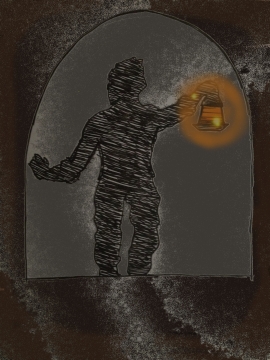Hello good reader!
This is the first post in a series that I will be doing on J.R.R. Tolkien’s “The Hobbit”. I don’t claim any particularly great knowledge of the world of Middle-Earth, or of Tolkien’s own literary process, style and goals, and that is precisely why I am doing this series – To learn new things about this secondary world that I love, and share them with others who desire the same. Think of this as more of a winding journey where the end isn’t especially important, where I don’t know a great deal more than you do, and discovery is the goal.
![IMG_0065[1]](https://themindcellar.files.wordpress.com/2014/11/img_00651-e1415597610664.jpg?w=185&h=300)
Now there is a lot that one can gleam on a close and thoughtful reading on The Hobbit’s first chapter, and frankly, I don’t possess the confidence to write on some of the insights I believe I’ve had in my reading, so today I’ll be sticking with one theme, and I’ll be approaching it from a few different angles. The theme I will be focussing on is how Tolkien draws his readers, adult and child alike, into the world of The Hobbit, and how despite marvelous, fanciful and some downright unbelievable occurences, readers come to accept the world the young Bilbo inhabits.
Bilbo comes from two very different hobbit families, the predictable and ‘prosy’ Baggins family, and the unpredictable and not-altogether proper Took family. These two groups coexist peacefully, with the Baggins side dominating, until the events that begin The Hobbit. When Bilbo’s quiet and comfortable life is disturbed by the dwarves, he begins to see a world that is far removed from his own. He sees a world full of golden treasures, wonderful toys, goblins and magnificent dragons. Bilbo seems to begin to fall in love with this world, albeit hesitantly. His hesitance is given an identity by the Baggins side of him, the part that doesn’t want to go gallivanting off on adventures, conversely the curious side of him is represented wholly by the Tookishness he tries so hard to dim. The tension between these two sides of Bilbo make up a lot of the content of the first chapter and give the reader not only an insight into Bilbo’s mind, but also an archetype to follow whilst accepting the fanciful world that they are entering into.
Bilbo offers the reader someone they can relate to on their own journey into the world, and just as he slowly becomes more accepting on the adventure that has been dropped into his lap, we as readers are slowly weaned of our dependency on reality, or at least the things we perceive as real, in the world of The Hobbit. Poems and stories are part of what encourages Bilbo to partake in the adventure set before him, and interestingly enough, provides a sort of how-to on, uhh, how to enjoy the book.
Tolkien had said that it wasn’t necessarily important on where an authors inspiration came from in created a secondary world, but that it was rather more important that the world is accepted and enjoyed by its readers (I must admit I can’t remember where or when he said this, I think it was in one of his essays, but I don’t know which one, I think I read an excerpt from it in the beginning of my edition of The Lord of the Rings), rather than being over analysed and turned into something utterly boring. Just like Bilbo is encouraged to accept and enjoy the adventure he has been thrust into, readers are subtly encouraged to do the same. So The Hobbit really set out the framework not only for the rest of the mythology of Middle-Earth, but also how it should be interacted with.
So, that’s the first part of this series done. I’m hoping to read Tolkien’s sub-creative works as they were intended, not to be overrun with analysis, but to be understood and enjoyed as what they are.
Until next time.
That is All.



![IMG_0065[1]](https://themindcellar.files.wordpress.com/2014/11/img_00651-e1415597610664.jpg?w=185&h=300)